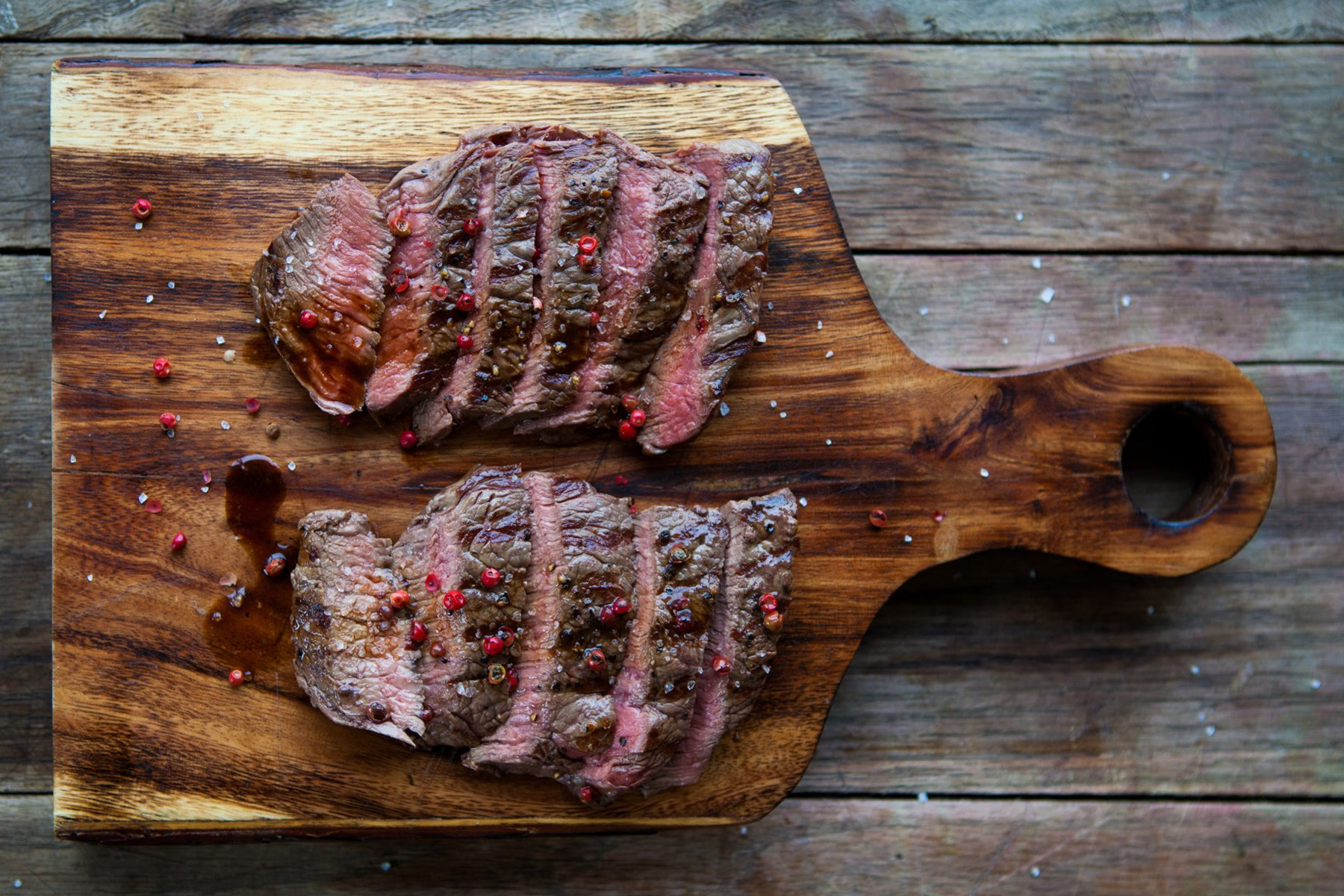How Rare Is Too Rare For Steak?
The way a steak is cooked is an individual choice that varies from person to person. A steak’s doneness effects not only it’s taste but also it’s texture. Whether it’s grilled, fried or cooked in an oven, cooking a steak to just the right temperature is just as important as seasonings and the cut. The most popular way to cook a steak is medium rare. However, many people prepare their steaks either rare or blue rare. Blue rare being almost a completely raw piece of meat. So how rare is too rare for a steak?
Steak that’s eaten too rare can pose a health risk. According to the US Department of Agriculture, raw steak should not be eaten or tasted. Even exposure to the juices can potentially make you sick. Raw meat may contain harmful bacteria like Salmonella, E.coli, and Shigella. To eliminate bacteria in or on the steak you have to cook it. Heat not only cooks the steak but also kills the bacteria. It’s very important to cook steak properly and handle raw meat with care. Wash surfaces, knives and utensils that touch the meat to avoid cross contamination.
Rare steak is cooked to an internal temperature of 125° Fahrenheit (52° C). This is the rarest most people will cook a steak. However some cook their steaks even rare which is called blue rare. Blue rare steak is cooked to an internal temperature of 115° Fahrenheit (46° C). This low a meat temperature is considered too rare for steak by many chefs.
If you like to eat really rare meat, the question is how rare is too rare when eating a steak? In this we’ll discuss how to cook a steak without creating a health risk.
How Rare Is Too Rare For Beef
A rare steak is considered under-cooked when it doesn’t reach the internal temperature of 125° Fahrenheit (52° C). Any steak or cut of beef that’s cooked rarer than this can potentially be dangerous to eat.
Cooking beef to an internal temperature of at least 125° Fahrenheit (52° C) helps ensure that harmful bacteria is killed. If beef does not reach this minimum temperature requirement, there’s a chance bacteria could still be alive when you eat it.
Knowing the right internal temperature to cook your beef to match the level of doneness you like is crucial. It not only makes consuming beef safer but also adds the enjoyment, flavor and tenderness of the meat.
The minimum internal temperature you cook beef should be 135°Fahrenheit (57°Celsius) for medium-rare steak and 125°Fahrenheit (52°Celsius) for rare steak.
Going below the rare recommended temperature means your steak will be too rare to eat. However some people like to eat blue rare meat, which is cooked to 115°Fahrenheit (46°Celsius) and even raw beef. I wouldn’t recommend either because eating meat this under-cooked could make you sick.
Cooking steak to rare alters the structure of the meat’s protein fibers. Beef contains tenderizing enzymes which become active when the meat is cooked. This is why cooking beef changes the steak’s appearance and texture. However, cooking meat for too long can kill the enzymes which makes the beef tough.
When you cook beef to medium-rare, the tenderizing enzymes are deactivated which causes the protein fibers to lose some of their slickness. This gives it a lighter red appearance and allows juices to flow out when the steak is sliced.
The reason most diners order rare or medium rare beef is because it’s generally the most flavorful and tender.
How To Cook A Steak That’s Not Too Rare
When you’re cooking a delicious steak dinner, it’s very important to cook the meat properly. Serving or eating under-cooked beef can cause illness due to bacteria that may be living in or on the meat.
To ensure the meat is cooked properly you should use a meat thermometer. Especially if you’re new to cooking beef. It’s the best way to guarantee the meat is cooked to a safe internal temperature. I know professional chefs that use a meat thermometer whenever they cook a rare steak. Especially when the cut is thick.
Many people will try to judge by looks or by feel how done a steak is. That can be OK if you’re cooking to a higher temperature, but a rare steak is always very close to being under-cooked. If you’re wrong by even a degree or two, the meat could be unsafe to eat.
Clear juices, a brown or charred outside, texture, or any other indicator isn’t as reliable as a good quality meat thermometer.
A meat thermometer is very easy to use. Simply stick it into the center of the meat and take a reading. Always jab the thermometer into the fattest portion of the meat because thick areas cook slower. Continue cooking until the internal temperature reaches at least 125° Fahrenheit (52° C).
Once the meat is taken off the heat, let it sit for about 5 minutes before serving. This time lets juices flow throughout the meat while it continues to cook. Meat will continue to cook inside another few degrees as it rests.
Properly cooked rare steak.
How Do You Know If Your Steak Is Too Rare
A properly cooked rare steak will come out charred on the outside but red on the inside. The inside of the meat will be red. As you get closer to the edges, the color will get less red and more pinkish. The inside will have a cooler temperature than the parts close to the edges.
A steak cooked rare should be soft and juicy.
A good sign that the steak is too rare is if the inside is blueish purple and cool. The internal temperature for a properly cooked rare steak is 125° Fahrenheit (52° C). This is hot enough to warm the inside and turn the meat’s color red.
Another good sign of under-cooked beef is an outside that’s cool or generally not cooked well. If the outside isn’t cooked then it’s safe to assume the inside isn’t either.
When eating rare beef, check the inside color at the fattest part of the steak. If it’s purple or cool then the meat is probably under-cooked. A properly cooked rare steak should be warm on the inside and reddish, not purple.
Don’t trust your eyes when determining if a steak is too rare to eat. Texture and color aren’t always accurate indications of how well beef has been cooked. To know for sure, use a good quality meat thermometer. It’s the only way you can accurately check the internal temperature of the meat.
If you like your steak well done, you don’t really need a meat thermometer. But the rarer you eat beef, the more important they become.
Buying Meat For A Rare Steak
If you like to eat meat as rare as possible, then it should be really fresh. The fresher the beef the better. Fresh meat has less time to grow bacteria which means less chance of potential illness from eating under-cooked beef.
There’s a big difference between beef that’s been sitting and properly aged meat. When you buy new meat at a food store or butcher, buy it as fresh as possible. I recommend buying beef from a butcher because they can package it right after the meat has been butchered.
When buying beef, always check the expiration date. Don’t buy meat that’s been sitting out on a refrigerated shelf. Even though the shelves at a super market are cold, they’re not freezing so the meat can still go bad.
Smell the meat, if it has an odor don;t buy it. Really fresh meat doesn’t have a bad smell.
Check the color, fresh meat is very red. As it ages the meat starts to turn brownish. Try to buy your beef as bright red as possible.
Here are some things to avoid when buying beef:
- An expired use by date
- Slimy, slick, or sticky to touch
- Color change from bold red to brown or green
- Unpleasant smell
- It’s been in the fridge (not the freezer) for more than 4-5 days
Although refrigerators are cold, they’re not a freezer. meat that sits out at a store or in your own fridge ages every day. When you cook rare steak, try to use the freshest beef possible because it’s the least likely to contain harmful bacteria.
Can I Get Sick From Eating Rare Steak?
Eating steak that’s too rare could pose a health risk due to harmful bacteria living in or on the meat. However,eating a properly cooked rare steak with an internal temperature of at least 125° Fahrenheit (52° C) will not make you sick.
There’s a difference between eating a properly cooked rare steak and eating beef that’s too rare. The difference is the internal temperature of the meat. As long as the beef is cooked to the proper temperature, harmful bacteria will be killed.
Even though a cut of beef may be high grade and bought fresh, it can still potential make you sick if eaten to raw. Bacteria can grow on meat no matter how good a cut it is. The way beef is handled from the time it’s butchered to the time it’s cooked is very important.
Under-cooking a steak may not kill all the harmful bacteria that may be living on it. Eating an under-cooked steak can make you sick, especially if you have a weak immune system.
Eating a rare steak that’s been inspected, properly handled and cooked the the required internal temperature of 125° Fahrenheit (52° C) should be fine to eat.
Is It OK To Eat Bloody Steak?
When steak is properly cooked to an internal temperature of at least 125° Fahrenheit (52° C), it’s safe to eat even if it looks a little bloody. Judging the doneness and safety of a piece of beef by eye isn’t that reliable. That’s why it’s so important to use a good quality food thermometer.
Always check the internal temperature of rare meat at it’s thickest point before you eat it to make sure it’s safe.
If you don’t have a food thermometer, cut the meat open at it’s thickest part. If the inside is cool and/or blueish, it’s probably under-cooked.
What color red are the juices? If they’re bright red blood, the meat is probably under-cooked. The juices flowing from a rare steak are either clear or pinkish but not usually bright red.
If you have any doubt about the meat, I’d cook it longer and to a higher temperature. This is why I recommend a medium-well steak. It’s still fairly rare but cooked enough to eliminate the doubt of being under-cooked.
If you like rare steak, make sure you only cook the freshest beef. The longer meat sits after being butchered the higher the chance it will grow harmful bacteria.
Summary: How Rare Is Too Rare For Steak?
The way a steak is cooked is an individual choice that varies from person to person. A steak’s doneness effects not only it’s taste but also it’s texture. Whether it’s grilled, fried or cooked in an oven, cooking a steak to just the right temperature is just as important as seasonings and the cut. The most popular way to cook a steak is medium rare. However, many people prepare their steaks either rare or blue rare. Blue rare being almost a completely raw piece of meat. So how rare is too rare for a steak?
Steak that’s eaten too rare can pose a health risk. According to the US Department of Agriculture, raw steak should not be eaten or tasted. Even exposure to the juices can potentially make you sick. Raw meat may contain harmful bacteria like Salmonella, E.coli, and Shigella. To eliminate bacteria in or on the steak you have to cook it. Heat not only cooks the steak but also kills the bacteria. It’s very important to cook steak properly and handle raw meat with care. Wash surfaces, knives and utensils that touch the meat to avoid cross contamination.
Rare steak is cooked to an internal temperature of 125° Fahrenheit (52° C). This is the rarest most people will cook a steak. However some cook their steaks even rare which is called blue rare. Blue rare steak is cooked to an internal temperature of 115° Fahrenheit (46° C). This low a meat temperature is considered too rare for steak by many chefs.
If you have any questions about cooking steak, email any time.























